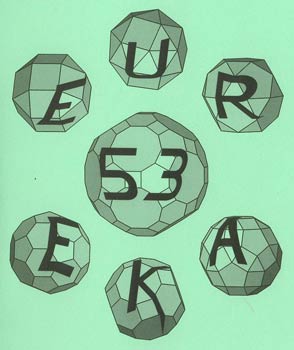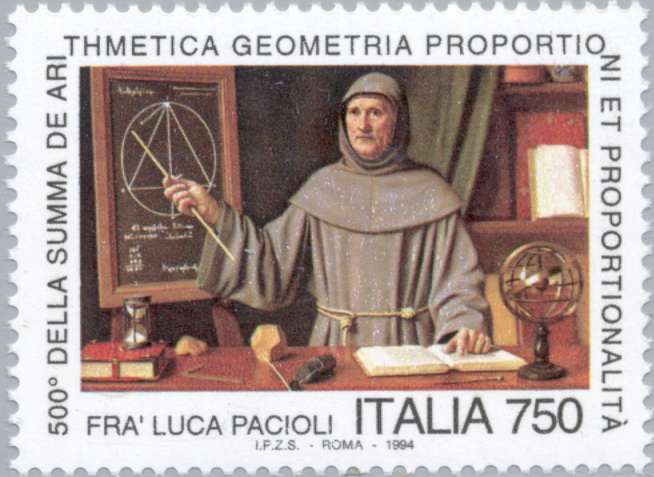.
Griechische Mathematik. Archimedische Polyeder
There is an astonishing imagination in practical mathematics; and Archimedes had at least as much imagination as Homer, Voltaire
Archimedes of Syracuse knew that there exist 13 convex semiregular polyhedra. The so-called Platonic polyhedra are formed from identical regular polygons. For example the cube is formed by 6 squares and the tetrahedron using 4 isosceles (all three sides have the same length) triangles. Archimedes considered the problem how many polyhedra can be obtained if we use 2 or more combinations of regular polygons. For example the “small rhombicosidodecahedron” can be formed by 20 isosceles triangles, 30 squares and 12 regular pentagons. There are only 13 possible semiregular polyhedra. These are called also Archimedean solids. Archimedes work about the semiregular polyhedra is lost but there are references made by the mathematician Pappus.

Eureka, the Journal of the Archimedeans (Issue 53, 1994)
Pappus of Alexandria (Πάππος ο Αλεξανδρεύς) (about 290-350) AD is the author of Μαθηματική Συναγωγή, or shortly Συναγωγή (Synagoge) (Mathematical Collections), He describes the Archimedean solids in the 5th book of the Synagoge: See http://www.mcs.drexel.edu/~crorres/Archimedes/Solids/Pappus.html for parts of Pappus text)
Each face is a regular polygon, and around every vertex, the same polygons appear in the same sequence, for example, hexagon - hexagon – triangle in the truncated tetrahedron as can be seen from the picture at the start of the section. Two or more different polygons appear in each of the Archimedean solids, unlike the platonic solids which each contain only one single type of polygon.
Classification
|
The Five Truncations Obtained from the corresponding Platonic Solids by dividing the edges into thirds and cutting off the vertices of these points. |
||||
|
truncated cube (3, 8, 8) |
truncated dodecahedron (3, 10, 10) |
truncated icosahedron (5, 6, 6) (geometry of the Carbon 60 molecule) or for less mathematical interested the shape of the soccer ball covered by pentagon and hexagons. |
truncated octahedron (4, 6, 6) |
truncated tetrahedron (3, 6, 6) |
|
Snub Polyhedra |
|
|
snub cube or snub cuboctahedron (3, 3, 3, 3, 4) |
snub dodecahedron or snub icosidodecahedron (3, 3, 3, 3, 5) |
|
Truncated-Quasiregular Polyhedra |
|
|
great rhombicosidodecahedron or truncated icosidodecahedron (4, 6, 10) |
great rhombicuboctahedron or truncated cuboctahedron (4, 6, 8) |
|
Snub Polyhedra |
|
|
snub cube or snub cuboctahedron (3, 3, 3, 3, 4) |
snub dodecahedron or snub icosidodecahedron (3, 3, 3, 3, 5) |
|
Quasi-regular Polyhedra |
|
|
cuboctahedron (3, 4, 3, 4) |
icosidodecahedron (3, 5, 3, 5) |
For the notations such as (3, 4, 3, 4) see: Info Source
|
user action |
applet reaction |
|---|---|
|
dragging (left mouse button pressed) |
rotating about an axis in the picture |
|
releasing left mouse button while dragging |
spinning about an axis in the picture |
|
SHIFT key pressed plus vertical dragging |
zooming |
|
SHIFT key pressed plus horizontal dragging |
rotating about an axis perpendicular to the picture |
|
CONTROL key pressed plus vertical dragging |
changing focal length |
|
Polyhedron |
Faces Number(Polygon) |
Edges |
Vertices |
|
Truncated Tetrahedron |
4(3), 4(6) |
18 |
12 |
|
Truncated Cube |
8(3), 6(8) |
36 |
24 |
|
Cuboctahedron |
8(3), 6(4) |
24 |
12 |
|
Truncated Octahedron |
8(6), 6(4) |
36 |
24 |
|
Small Rhombicuboctahedron |
8(3) ,18(4) |
48 |
24 |
|
Great Rhombicuboctahedron |
12(4), 8(6), 6(8) |
72 |
48 |
|
Snub Cube |
32(3), 6(4) |
60 |
24 |
|
Truncated Dodecahedron |
20(3), 12(10) |
90 |
60 |
|
Icosidodecahedron |
20(3), 12(5) |
60 |
30 |
|
Truncated Icosahedron |
12(5), 20(6) |
90 |
60 |
|
Small Rhombicosidodecahedron |
20(3), 30(4), 12(5) |
120 |
60 |
|
Great Rhombicosidodecahedron |
30(4), 20(6), 12(10) |
180 |
120 |
|
Snub Dodecahedron |
80(3), 12(5) |
150 |
60 |

Kepler and Luca Pacioli after Archimedes were interested in these solids. Pacioli showed a truncated icosahedron in his book De Divina Proportione published around 1509. A regular dodecahedron is shown in the stamp one of the 5 regular Platonic solids.
For a more precise mathematical definition of these geometrical objects see Archimedean Polyhedra
References
Polyhedra, Peter R. Cromwell, Cambridge University Press, 1997. 451 pp. ISBN 0-521-55432
The Works of Archimedes: Translation and Commentary, Vol. 1 Reviel Netz, Cambridge University Press 2004
The Works of Archimedes , Thomas Little Heath, Dover Publications, Incorporated 2002
LINKS
Download PDF Files with paper models of the Archimedian and Platonic solids
Do Mathematicians Think Logically?
Translation from the fifth book of the "Collection" of the Greek mathematician Pappus of Alexandria
Miscellaneous
Poly, a shareware program for exploring and constructing polyhedra
Marco Möller, Vierdimensionale Archimedische Polytope, PhD Thesis, Hamburg 2004 (German)
| Ancient Greece
Science, Technology , Medicine , Warfare, , Biographies , Life , Cities/Places/Maps , Arts , Literature , Philosophy ,Olympics, Mythology , History , Images Medieval Greece / Byzantine Empire Science, Technology, Arts, , Warfare , Literature, Biographies, Icons, History Modern Greece Cities, Islands, Regions, Fauna/Flora ,Biographies , History , Warfare, Science/Technology, Literature, Music , Arts , Film/Actors , Sport , Fashion --- |

